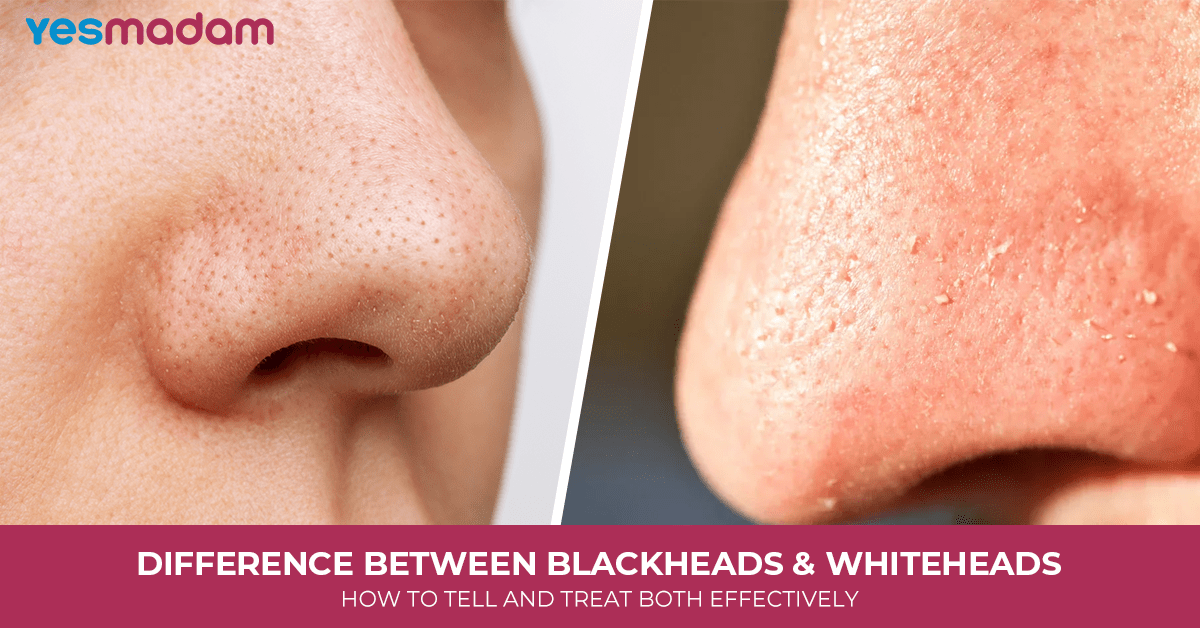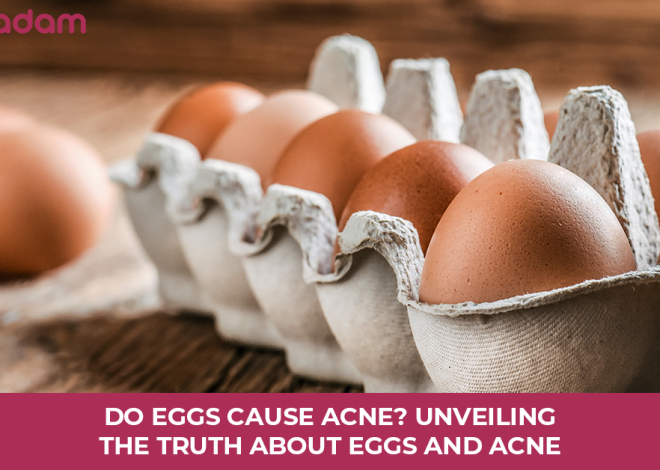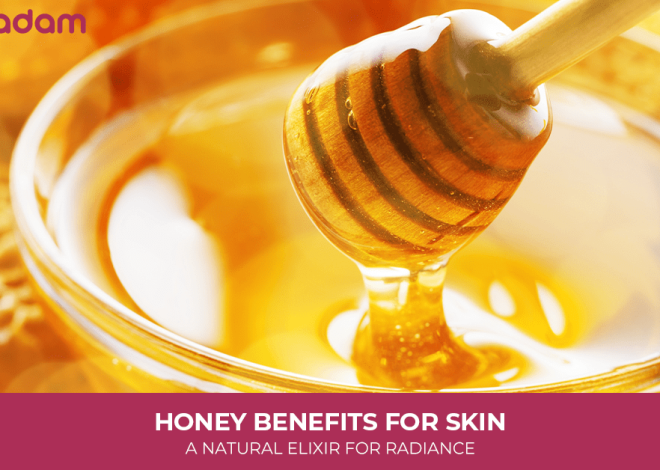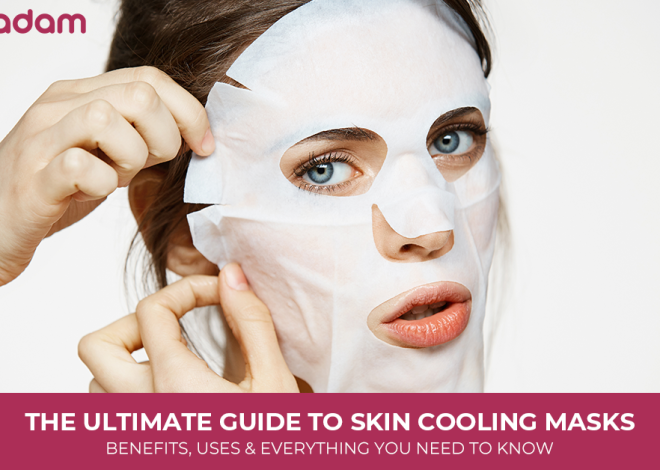
Difference Between Blackheads and Whiteheads: How To Tell and Treat Both Effectively
Achieving beautiful, radiant, and clear skin is a top priority for every individual. But common skin problems like blackheads and whiteheads may be ruining your picture-perfect skin’s dream.
While both blackheads and whiteheads fall under the umbrella category of acne, each has distinct characteristics and needs specific treatment approaches.
To help you with sure-shot treatments and effective tips to keep these pesky skin concerns at bay, let’s focus on understanding the difference between blackheads and whiteheads in this blog.
Table of Contents
What Are Blackheads?
Blackheads at first sight may look like tiny black dots. In reality, this is a non-inflammatory acne that occurs due to dead cells and sebum clogging your pores on the face. Blackheads have wider openings on the skin’s surface, and so, allow the air to enter and oxidize the melanin, for that characteristic black colour.
Blackheads are usually found on the forehead, face, nose, and chin areas where the skin produces a generous amount of oil.
What Are Whiteheads?
Whiteheads are the small, yellowish or white bumps that stick out of the hair follicles. It is yet another type of non-inflammatory acne, which occurs when buildup clogs the pores. But, opposed to blackheads, whiteheads have smaller openings on the skin’s surface and don’t allow air to enter. Due to this, whiteheads are often referred to as closed comedones.
Whiteheads, as tiny, round bumps, usually appear on the face, shoulders, chest, neck, and back.
Difference Between Blackheads and Whiteheads

The key whitehead and blackhead difference lies in the fact that blackheads have open pores that allow trapped oil and dead skin cells to oxidize and turn black, while whiteheads are closed pores with a thin layer of skin covering the trapped sebum and dead skin cells, preventing oxidation and resulting in a white or flesh-colored appearance.
Blackheads
- Appearance: Dark or black, small, open bumps on the skin’s surface.
- Formation: The pore is open, and the trapped material (sebum, dead skin cells) reacts with the air and oxidizes, causing it to turn black.
- Nature: Known as open comedones.
Whiteheads
- Appearance: Small, white or flesh-colored bumps beneath a thin layer of skin.
- Formation: The pore remains closed, trapping the sebum and dead skin cells beneath the skin’s surface and preventing exposure to air and oxidation.
- Nature: Known as closed comedones.
Shared Causes
Both blackheads and whiteheads form when hair follicles become clogged with a mixture of: Excess oil (sebum), Dead skin cells, Dirt and other impurities, and Bacteria.
Whiteheads vs Blackheads: A Step-by-Step Guide On Treatments For Each
You can manage both blackheads and whiteheads effectively by adopting a consistent skincare routine as highlighted below:
A step-by-step guide on whiteheads treatment
The strategies listed below will help treat and prevent whiteheads effectively:
- Gently wash the skin with mild soap and lukewarm water twice a day.
- Pat face dry without rubbing.
- Do not squeeze pimples and touch the skin unnecessarily.
- Shave cautiously
- Avoid excessive sun exposure, which can cause burns or tanning.
- Apply non-comedogenic , oil-free skincare products to prevent clogging pores.
- Apply cosmetics sparingly.
- Wipe off makeup before going to bed.
- To treat dry skin, use fragrance-free, water-based emollient products.
- Rinse the hair regularly and keep hairspray away from the face.
- Switch to loose clothing made of natural fabrics like linen, hemp, and cotton.
- Include a healthy diet with fewer sugary drinks and high-sodium food.
More Information For You: Honey Benefits for Skin
An easy step-by-step guide on blackheads treatment
Here are the tips that will help you get rid of blackheads and prevent their future formation:
1. Cleanse with salicylic acid
It is the most suitable ingredient for treating blackheads, as it helps break down the materials that clog pores.
2. Exfoliate gently with AHAs and BHAs
For blackheads, regular exfoliation with AHAs and BHAs can help eliminate excess amounts of dead skin cells, which may cause clogged pores, besides removing existing blackheads too.
4. Buy a skin brush
A skin brush, along with your daily cleanser, may provide similar exfoliating benefits by eliminating excess dead skin cells and existing blackheads.
5. Topical retinoids
Retinoids may be effective for stubborn cases of blackheads. But those with dry skin should avoid using retinoids altogether.
6. Use a clay mask
Clay masks help flush oils and toxins out of the skin to unclog pores. Certain clay masks also include sulfur, which, as an ingredient, works to break down dead skin cells that make up blackheads.
7. Apply a charcoal mask
Similar to clay masks, charcoal masks are beneficial for treating blackheads.
8. Consider a chemical peel
Though not regarded as a primary treatment for blackheads, chemical peels may eliminate dead skin cells and reduce enlarged pores.
9. Use non-comedogenic products
It is better to kickstart a blackhead removal regimen using non-comedogenic products. These products don’t cause clogged pores or comedones.
10. Avoid sleeping in makeup
The last crucial thing before going to bed at night is to remove your makeup. As sleeping with your makeup on is like asking for more blackheads.
11. Avoid pore strips and other home extraction methods
While it may be tempting to opt for extraction or pore strips to get rid of those pesky blackheads, when placed into the hands with limited experience, extraction tools may be a source of wounds, scratches, or even scars.
12. Don’t use benzoyl peroxide
Benzoyl peroxide, found in most of the over-the-counter products, doesn’t treat inflammatory acne. And since blackheads are not considered inflammatory, using products featuring benzoyl peroxide won’t do much good.
13. Consult your dermatologist
Any new acne regimen, including the one for blackheads, may take anywhere from 6-12 weeks to take effect. If you notice new and existing blackheads after this time, book an appointment with your dermatologist to prevent blackheads from coming back.
A Few Other Ways to Get Rid of Blackheads or Whiteheads

Preventive tips for blackheads or whiteheads involve a comprehensive yet holistic approach and include:
1. Lifestyle measures
- Hydration: Use a non-comedogenic moisturiser to keep your skin well-hydrated and prevent breakouts.
- Balanced diet: Include a well-rounded diet with whole grains, vegetables, and fruits. Reduce intake of dairy and high-glycemic foods to mitigate the possibility of acne breakouts.
- Avoid touching: Avoid the urge to touch your face, as hands may transfer bacteria or dirt, causing clogged pores.
- Hygiene practices: Make sure that items that come into contact with your face, like makeup brushes and pillow cases, are kept clean. Dirty surfaces may harbour bacteria, causing acne.
2. Professional treatments
- Chemical peels: Help remove the outer skin layer, decreasing the apperance of blackheads and whiteheads.
- Professional Extraction: Can safely remove blackheads and whiteheads without any damage to the skin.
- Laser and light therapy: Such treatments may reduce oil production and kill acne-causing bacteria.
3. Home remedies
- Facial steam: Steaming the face can help soften whiteheads and blackheads, making them easier to remove.
- Tea tree oil: Antibacterial properties help in the battle against bacteria that cause acne. Dilute a few drops of tea tree oil with carrier oil ( like coconut oil or jojoba oil) and apply it to the affected area directly.
- Witch hazel: As a natural astringent, it tightens pores and reduces oiliness. Apply its extract on the skin using a cotton ball, targeting breakout-prone areas.
- Apple cider vinegar: Helps get rid of acne. Ensure to do a patch test if you have sensitive skin.
- Oatmeal: It is a gentle exfoliant and soothes irritated skin. Prepare a mask by mixing ground oatmeal with water or yogurt. Apply it to the face 15-20 minutes before washing.
- Lemon juice: Citric acid in it can help brighten and exfoliate skin. Mix lemon juice with water and apply it over dark patches or acne-prone areas.
- Honey, sugar, and olive oil mix: Apply the mix of three ingredients once a week to help eliminate blackheads and whiteheads.
Common Myths About Blackheads and Whiteheads Debunked
Debunking the myths and understanding the facts will help you manage your whiteheads and blackheads better and achieve healthier, clearer skin:
Myth 1: Blackheads are dirt in your pores
Fact: while blackheads may appear like dirt, they look so due to oxidized oil and skin cells, not dirt.
Myth 2: You can touch whiteheads
Fact: No, touching or squeezing whiteheads may cause scarring and the spread of bacteria. So, avoid squeezing them and let the treatment do the work.
Myth 3: Blackheads and whiteheads occur due to poor hygiene
Fact: Contrary to popular belief, blackheads or whiteheads are not caused by poor hygiene, but due to hair follicles getting clogged with oil and dead skin cells. Avoid washing too frequently or scrubbing too vigorously.
Myth 4: Blackheads only affect oily skin
Fact: Although more common in oily skin, blackheads may also affect people with normal or combination skin, more so if they don’t follow a good skincare routine.
Myth 5: Make Up Causes Blackheads and Whiteheads
Fact: Not all makeup causes blackheads or whiteheads. The key is to use non-comedogenic products that are designed not to clog pores. Also, removing makeup thoroughly before bed may help prevent breakouts.
Conclusion
Understanding the difference between blackheads and whiteheads is important for effective treatment. Creating a proper skincare routine, following a healthy lifestyle, and availing both natural and professional treatments are necessary to achieve lovely and clear skin. Dermatologists may also help you with a customized skincare routine tailored to your skin type.
FAQs
How to treat whiteheads vs blackheads on nose?
To treat whiteheads or blackheads on the nose, follow the tips as highlighted below:
- Gentle cleansing: Use a pH-balancing, gentle cleanser to eliminate grime, dirt, and dead cells from the nose.
- Regularly exfoliate: Use a chemical exfoliant or physical scrub to remove stubborn buildup from the nose.
- Use nose strips occasionally: Use a pore strip occasionally to extract deep-seated impurities from the nose.
- Moisturise: To prevent sebaceous glands from going into overdrive mode.
Are blackheads and whiteheads both types of acne?
Yes, both are considered non-inflammatory acne. They are mild forms of acne that occur when pores get clogged with sebum, dirt, and dead skin cells, but without significant redness or swelling.
Why do blackheads appear darker than whiteheads?
Blackheads look dark because the sebum and dead skin inside the open pore oxidize when exposed to air, turning black. It’s not due to dirt or poor hygiene, as commonly believed.
Which is more common — blackheads or whiteheads?
Blackheads are generally more common, especially in people with oily or combination skin. They often appear on the nose, chin, and forehead areas.
Can I squeeze blackheads and whiteheads to remove them?
It’s best to avoid squeezing them, as this can lead to inflammation, scarring, or infection. Instead, use exfoliating acids like salicylic acid or retinoids to unclog pores safely.
How can I prevent blackheads and whiteheads?
Keep pores clean by cleansing twice daily, exfoliating regularly with BHA (salicylic acid), and avoiding heavy or pore-clogging products. Also, remove makeup before sleeping and maintain a balanced diet.
Where do blackheads and whiteheads usually appear?
They mostly appear in the T-zone (nose, forehead, and chin) where oil production is higher. However, they can also occur on the cheeks, chest, shoulders, and back.
Which skin type is more prone to blackheads and whiteheads?
People with oily and combination skin types are more prone because their sebaceous glands produce more oil, increasing the chance of clogged pores.
Do blackheads and whiteheads require different treatments?
While both benefit from regular exfoliation and cleansing, blackheads respond better to BHA (which penetrates pores), while whiteheads can improve with retinoids that speed up cell turnover.
Can professional treatments help remove blackheads and whiteheads?
Yes, professional options like chemical peels, microdermabrasion, or extractions by dermatologists can safely remove them and improve skin texture without causing damage.



